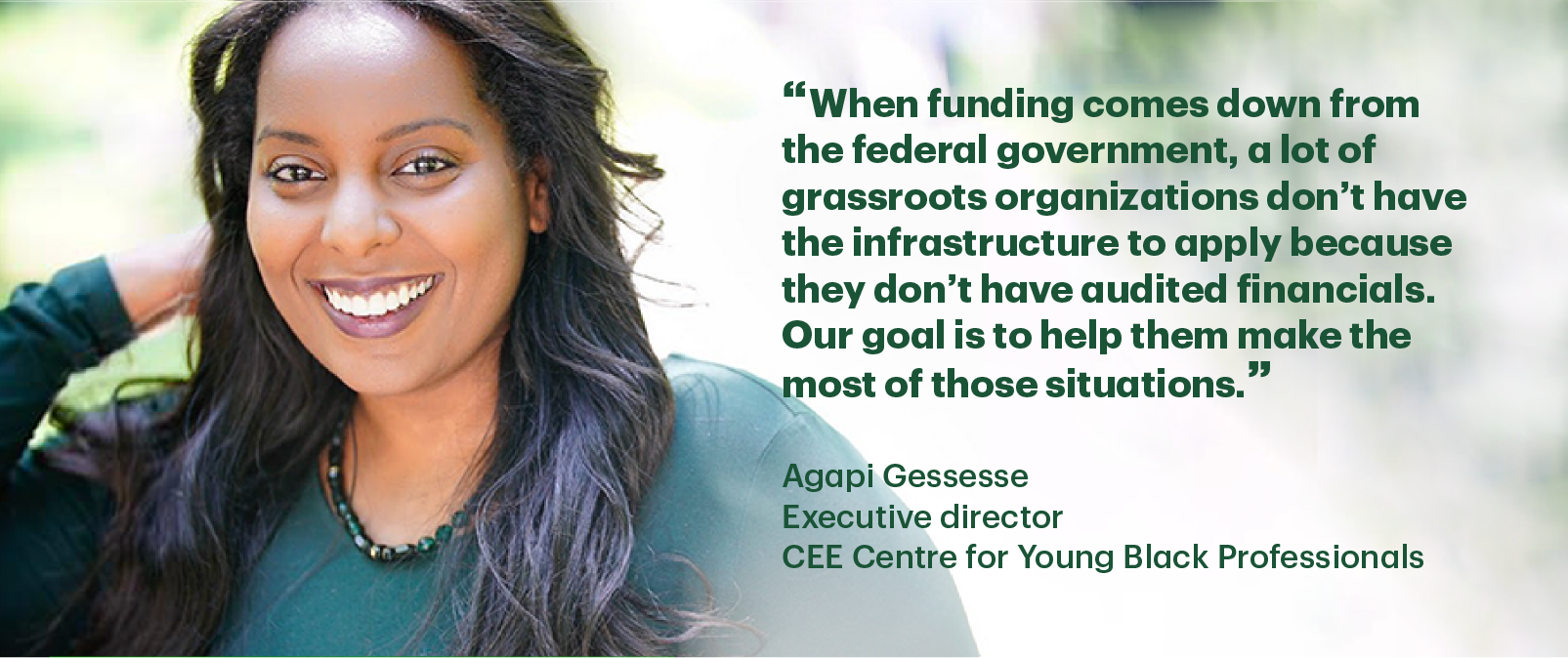For Agapi Gessesse, the COVID-19 pandemic made a difficult situation even worse.
Since 2018, Gessesse has served as the executive director of the CEE Centre for Young Black Professionals, a Toronto-based not-for-profit that was established to address the economic and social barriers affecting Black youth. The organization offers programs and training designed to help improve the career opportunities of young Black professionals in areas such as technology, trades, and social services.
Even before the pandemic, funding for Black-led programs such as those run by CEE, (which stands for Careers Education Empowerment) rarely kept up with demand, Gessesse said. And when the far-reaching societal effects of COVID-19 began to disrupt the lives of millions of Canadians last year, Black communities were among those most affected.
According to Statistics Canada, visible minorities, including Black communities, are more likely to work in industries worst affected by the pandemic – including hospitality and retail services – compounding health and economic risks. At the same time, StatsCan data shows that even as unemployment fell in the second half of 2020, unemployment in the Black community (17.6%) continued to outpace the national average (9.4%).
The result was that demand for the kind of training and employment services offered by CEE and its partner organizations skyrocketed, while funding declined, and services were forced to close as a result of physical distancing measures.
“When something that affects everybody happens very suddenly, like COVID-19, you have to able to respond to the demand," Gessesse said.
"But in order to do that, you need to have the resources and you need to have the people. And because Black-led organizations and Black communities have been in survival mode for so long, there's no breathing room when disaster strikes."
A disproportionate effect
In April of 2020, with governments implementing lockdown restrictions in an attempt to stop the spread of COVID-19, Gessesse worried it would have a disproportionate effect on Black communities, as well as other racialized communities across Canada.
The previous month, CEE’s team of three social workers went from supporting 15 young people to more than 140. Some of those had lost their jobs and needed food or baby supplies, while others were facing homelessness due to pandemic-related hardships.
At risk of burn out, it was impossible for Gessesse and her team to maintain this level of support on a continued basis, so she set out to form partnerships among different B3 organizations. B3 organizations are defined as being Black-focused, Black-led, and/or Black-serving groups; they play a critical role in assisting vulnerable members of the Black community because they better understand the needs of those they are helping and how to support them in a way that is effective.
CEE partnered with the Network for the Advancement of Black Communities (NABC) to conduct a nationwide survey to understand the needs of grassroots and emerging B3 organizations. Eventually, these insights would enable CEE to secure their much-needed funding.
CEE sent the resulting report to key players, which Gessesse believes was the catalyst for the decision from the City of Toronto and the Province of Ontario to contribute a combined $4.5-million directly into Black Communities.
"COVID-19 has amplified existing inequities impacting Black Communities," Gessesse wrote in the report.
"Emergency funds are needed to reach out to and support isolated seniors, the homeless, those requiring mental health counseling, single-mother households, people with pre-existing medical conditions, marginalized and impoverished community members, those with disabilities, those for whom food insecurity is a health concern and caregivers of these vulnerable segments."

Recovery, Healing & Resilience
With the new allocation of dollars, CEE created the Black Canadian Communities – Recovery, Healing & Resilience (RHR) Program, and helped act as a trustee organization.
“When funding comes down from the federal government, a lot of grassroots organizations don’t have the infrastructure to apply because they don’t have audited financials,” Gessesse said. "Our goal is to help them make the most of these funding opportunities."
The RHR program was designed to address those barriers, and others, that B3 organizations face including capacity to serve their constituents and a standard of work so they can actually take advantage when opportunities arise.
In addition to helping B3 organizations develop adaptive capacities like succession planning, policy development and grant-writing expertise, the program will also equip them with Afro-centric tools and rituals to support the healing of Black communities, as well as a peer learning networks and a five-year B3 Community Ecosystem Action plan to help build unity of purpose in the B3 sector.
According to Gessesse, the goal is that Black community members are better connected to local organizations, and that B3 organizations have more capacity and are better connected to one another, so that they can work together to address larger systemic inequities and policy challenges.
“In order for us to be able to fulfill our mission, we need to maintain a strong, co-ordinated network of B3 agencies working together to fight the discriminatory impacts of COVID and empower our communities as we work toward an inclusive recovery,” says Gessesse.
The RHR Program recently received a 2020 TD Ready Challenge grant for $650,000 CAD for its dedication to helping Black communities strengthen resilience and recover post-pandemic.
Included as part of the TD Community Resilience Initiative, aimed at supporting COVID-19 recovery and building community resilience, the 2020 TD Ready Challenge awarded grants ranging from $350,000 to $1-million CAD to 15 non-profit organizations in Canada and the United States offering innovative solutions to help address the growing inequities exacerbated by the pandemic.
"I rarely cry but I fell into tears because this is what our entire community needs – it’s not even just about CEE or NABC. It’s going to help an entire ecosystem and it’s such a huge win for the Black community,” Gessesse said.
CEE and NABC continue to engage with groups to find ways to build capacity; NABC focuses on system navigation while CEE focuses on practical learning labs and capacity building.
